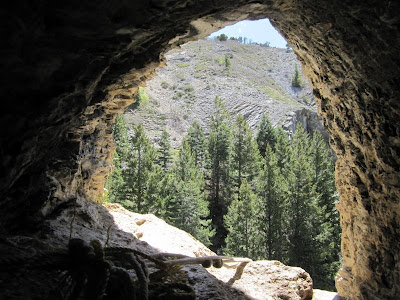Pole Creek Cave is a large horizontal cave that is great for beginners to explore. It is only accessible in the fall since the Pole Creek river comes out of the entrance at high flow levels. The dry portion of the cave is roughly 900' long and ends at a pool of water that remains year round. The pool is diveable and is roughly 200' long and then continues 500' in another dry portion of the cave until another pool is encountered. Currently Underwater Dynamics is exploring the second pool in hopes of pushing it further. The end goal is to connect the entrance with the upper sink that is 1.5 miles away.
When I visited the cave in the spring (see image below) a heavy flow of water was coming from the entry. Warning! No attempt should be made to enter this cave when water is flowing out of the entry!
The Pole Creek Sink (see image below) located about 1.5 miles upstream from the cave entrance is where the river disappears into the cave system. With the high runoff this spring (2011) the sink filled up to where you could barely see the top of the right mine entrance.
The two large black holes in the photo are an attempt by Gale Rhoades to open an old Spanish mine he located in the sink. You can read more about the venture here.
Cameron Coles standing in front of the sink.


























 As you can see by the photos these caves are mostly tight passages. To enter Interstate Cave requires a permit as well as about 300' of rope as it requires a rappel to enter the cave and to descend to the lower passages. Entrance to this cave is highly discouraged as there are delicate gypsum formations in it's tight passages.
As you can see by the photos these caves are mostly tight passages. To enter Interstate Cave requires a permit as well as about 300' of rope as it requires a rappel to enter the cave and to descend to the lower passages. Entrance to this cave is highly discouraged as there are delicate gypsum formations in it's tight passages. 


















 The only name we have for this cave is 'Limestone Cave'. It is obviously a well traveled and well known cave. It is in the Wendover area and it's up a very cool little canyon.
The only name we have for this cave is 'Limestone Cave'. It is obviously a well traveled and well known cave. It is in the Wendover area and it's up a very cool little canyon.

 As I was dressed in my business clothes and did not bring along my coveralls I did not attempt to crawl thru the 'moon dust' to see where the tight crawl went.
As I was dressed in my business clothes and did not bring along my coveralls I did not attempt to crawl thru the 'moon dust' to see where the tight crawl went. The only formations that I noticed in this cave are what appeared to me to be mamilaries. These bulbus formations are said to form only underwater.
The only formations that I noticed in this cave are what appeared to me to be mamilaries. These bulbus formations are said to form only underwater. Because this apparently is a well known and visited cave I am posting these wider angle shots showing the topography, and the trusty 4Runner as well.
Because this apparently is a well known and visited cave I am posting these wider angle shots showing the topography, and the trusty 4Runner as well. 




